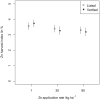Agronomic biofortification increases grain zinc concentration of maize grown under contrasting soil types in Malawi
- PMID: 36348768
- PMCID: PMC9631327
- DOI: 10.1002/pld3.458
Agronomic biofortification increases grain zinc concentration of maize grown under contrasting soil types in Malawi
Abstract
Zinc (Zn) deficiency remains a public health problem in Malawi, especially among poor and marginalized rural populations, linked with low dietary intake of Zn due to consumption of staple foods that are low in Zn content. The concentration of Zn in staple cereal grain can be increased through application of Zn-enriched fertilizers, a process called agronomic biofortification or agro-fortification. Field experiments were conducted at three Agricultural Research Station sites to assess the potential of agronomic biofortification to improve Zn concentration in maize grain in Malawi as described in registered report published previously. The hypotheses of the study were (i) that application of Zn-enriched fertilizers would increase in the concentration of Zn in maize grain to benefit dietary requirements of Zn and (ii) that Zn concentration in maize grain and the effectiveness of agronomic biofortification would be different between soil types. At each site two different subsites were used, each corresponding to one of two agriculturally important soil types of Malawi, Lixisols and Vertisols. Within each subsite, three Zn fertilizer rates (1, 30, and 90 kg ha-1) were applied to experimental plots, using standard soil application methods, in a randomized complete block design. The experiment had 10 replicates at each of the three sites as informed by a power analysis from a pilot study, published in the registered report for this experiment, designed to detect a 10% increase in grain Zn concentration at 90 kg ha-1, relative to the concentration at 1 kg ha-1. At harvest, maize grain yield and Zn concentration in grain were measured, and Zn uptake by maize grain and Zn harvest index were calculated. At 30 kg ha-1, Zn fertilizer increased maize grain yields by 11% compared with nationally recommended application rate of 1 kg ha-1. Grain Zn concentration increased by 15% and uptake by 23% at the application rate of 30 kg ha-1 relative to the national recommendation rate. The effects of Zn fertilizer application rate on the response variables were not dependent on soil type. The current study demonstrates the importance of increasing the national recommendation rate of Zn fertilizer to improve maize yield and increase the Zn nutritional value of the staple crop.
Keywords: Lixisols; Vertisols; agro‐fortification; maize; zinc deficiency; zinc‐enriched fertilizers.
© 2022 The Authors. Plant Direct published by American Society of Plant Biologists and the Society for Experimental Biology and John Wiley & Sons Ltd.
Conflict of interest statement
The authors declare no competing interests.
Figures






Similar articles
-
Impact of zinc and iron agronomic biofortification on grain mineral concentration of finger millet varieties as affected by location and slope.Front Nutr. 2023 May 5;10:1159833. doi: 10.3389/fnut.2023.1159833. eCollection 2023. Front Nutr. 2023. PMID: 37215208 Free PMC article.
-
Increasing zinc concentration in maize grown under contrasting soil types in Malawi through agronomic biofortification: Trial protocol for a field experiment to detect small effect sizes.Plant Direct. 2020 Oct 22;4(10):e00277. doi: 10.1002/pld3.277. eCollection 2020 Oct. Plant Direct. 2020. PMID: 33103047 Free PMC article.
-
Soil and landscape factors influence geospatial variation in maize grain zinc concentration in Malawi.Sci Rep. 2022 May 14;12(1):7986. doi: 10.1038/s41598-022-12014-w. Sci Rep. 2022. PMID: 35568698 Free PMC article.
-
Enrichment of fertilizers with zinc: An excellent investment for humanity and crop production in India.J Trace Elem Med Biol. 2009;23(4):281-9. doi: 10.1016/j.jtemb.2009.05.002. Epub 2009 Jun 12. J Trace Elem Med Biol. 2009. PMID: 19747624 Review.
-
Agronomic bio-fortification of wheat (Triticum aestivum L.) to alleviate zinc deficiency in human being.Rev Environ Sci Biotechnol. 2023;22(2):505-526. doi: 10.1007/s11157-023-09653-4. Epub 2023 Apr 27. Rev Environ Sci Biotechnol. 2023. PMID: 37234132 Free PMC article. Review.
Cited by
-
Impact of zinc and iron agronomic biofortification on grain mineral concentration of finger millet varieties as affected by location and slope.Front Nutr. 2023 May 5;10:1159833. doi: 10.3389/fnut.2023.1159833. eCollection 2023. Front Nutr. 2023. PMID: 37215208 Free PMC article.
-
Technologies in Agronomic Biofortification with Zinc in Brazil: A Review.Plants (Basel). 2025 Jun 14;14(12):1828. doi: 10.3390/plants14121828. Plants (Basel). 2025. PMID: 40573820 Free PMC article. Review.
References
-
- Abunyewa, A. A. , & Mercie‐Quarshie, H. (2004). Response to maize to magnesium and zinc application in the semi‐arid zone of West Africa. Asian Journal of Plant Sciences, 3(1), 1–5.
-
- Boawn, L. C. (1974). Residual availability of fertilizer zinc. Soil Science Society of America Journal, 38, 800–803. 10.2136/sssaj1974.03615995003800050031x - DOI
-
- Botoman, L. , Nalivata, P. C. , Chimungu, J. G. , Munthali, M. W. , Bailey, E. H. , Ander, E. L. , Lark, R. M. , Mossa, A. W. , Young, S. D. , & Broadley, M. R. (2020). Increasing zinc concentration in maize grown under contrasting soil types in Malawi through agronomic biofortification: Trial protocol for a field experiment to detect small effect sizes. Plant Direct, 4, e00277. 10.1002/pld3.277 - DOI - PMC - PubMed
-
- Brennan, R. F. , & Bolland, M. D. A. (2007). Estimating the long‐term residual value of zinc oxide for growing wheat in a sandy duplex soil. Australian Journal of Agricultural Research, 58, 57–65. 10.1071/AR06169 - DOI
LinkOut - more resources
Full Text Sources
Research Materials

